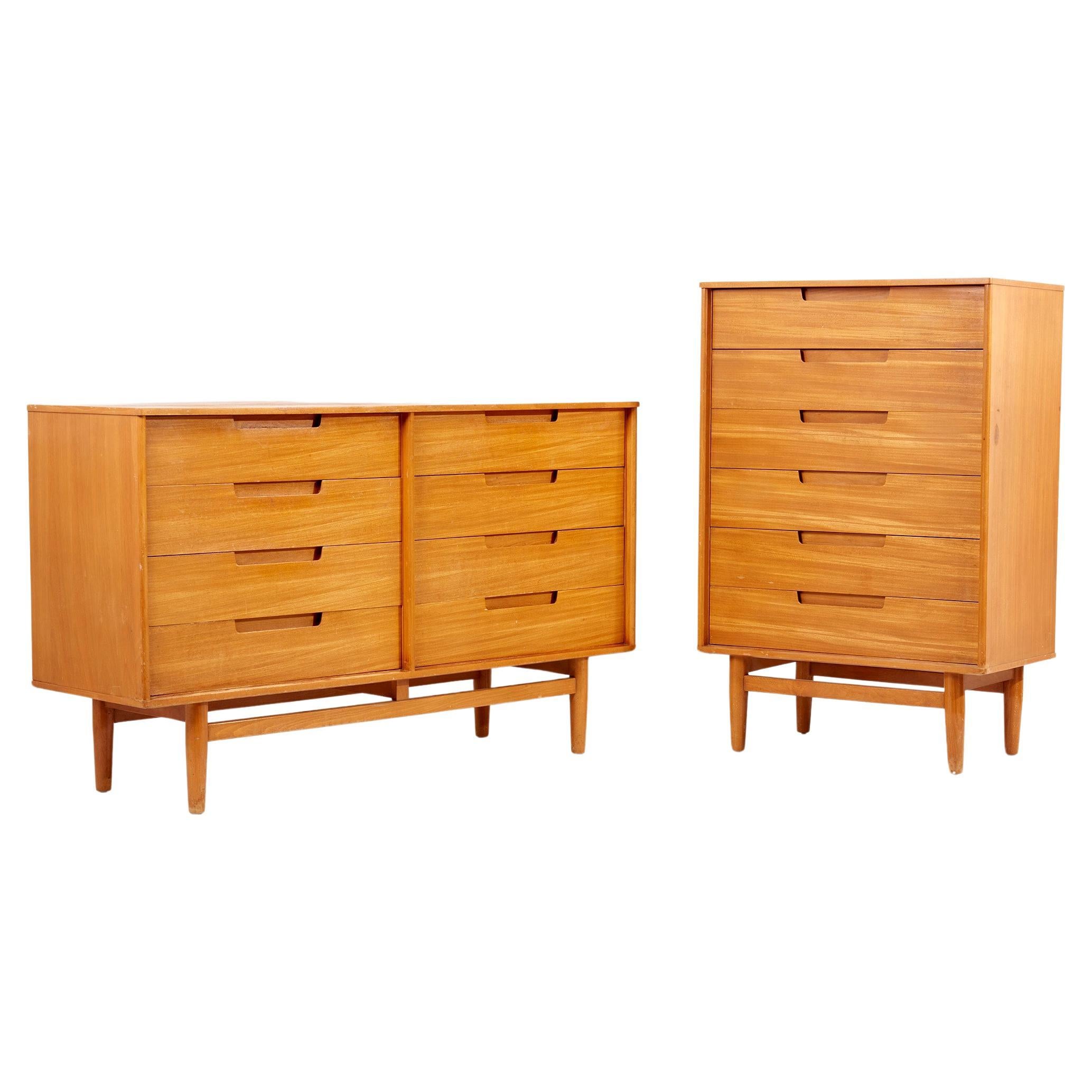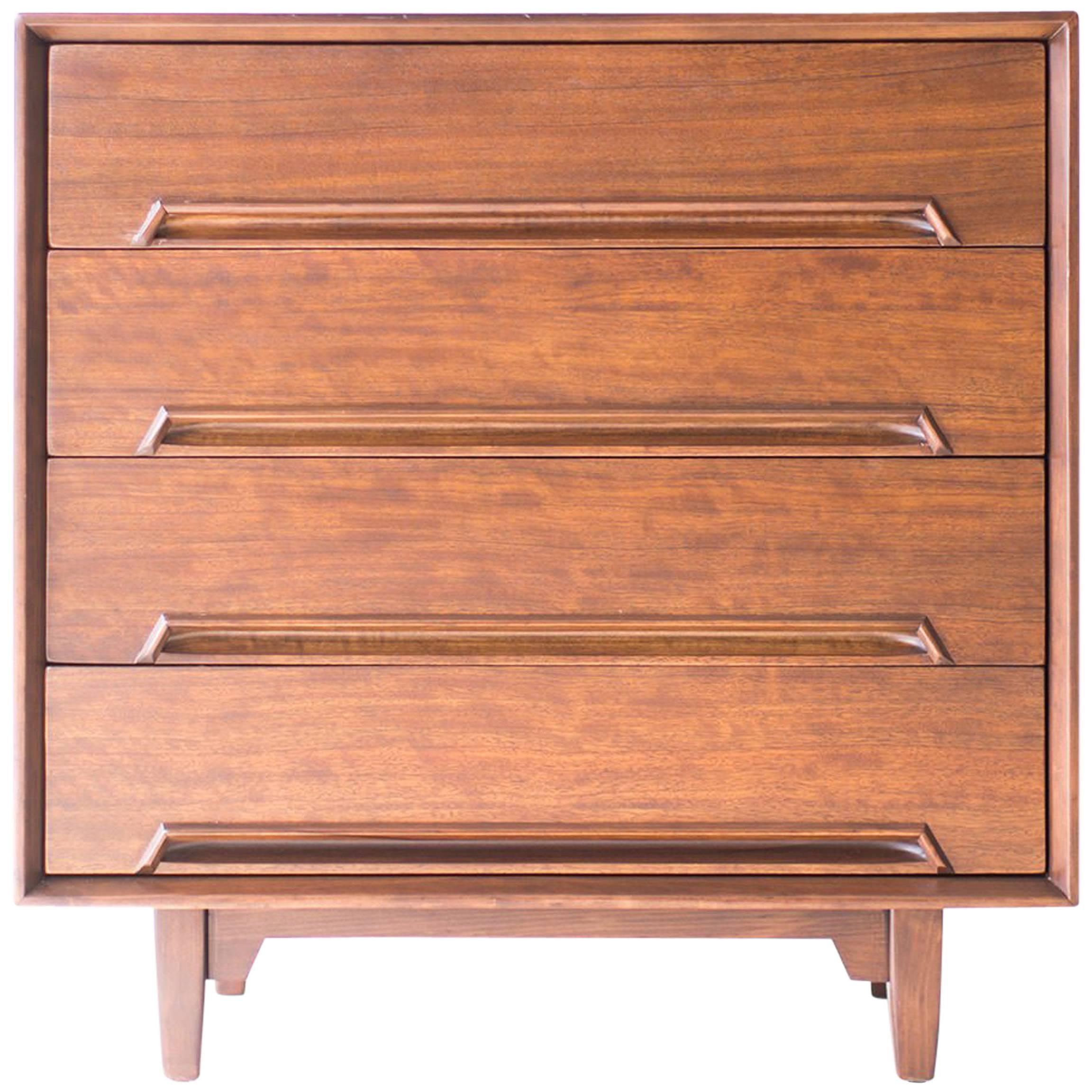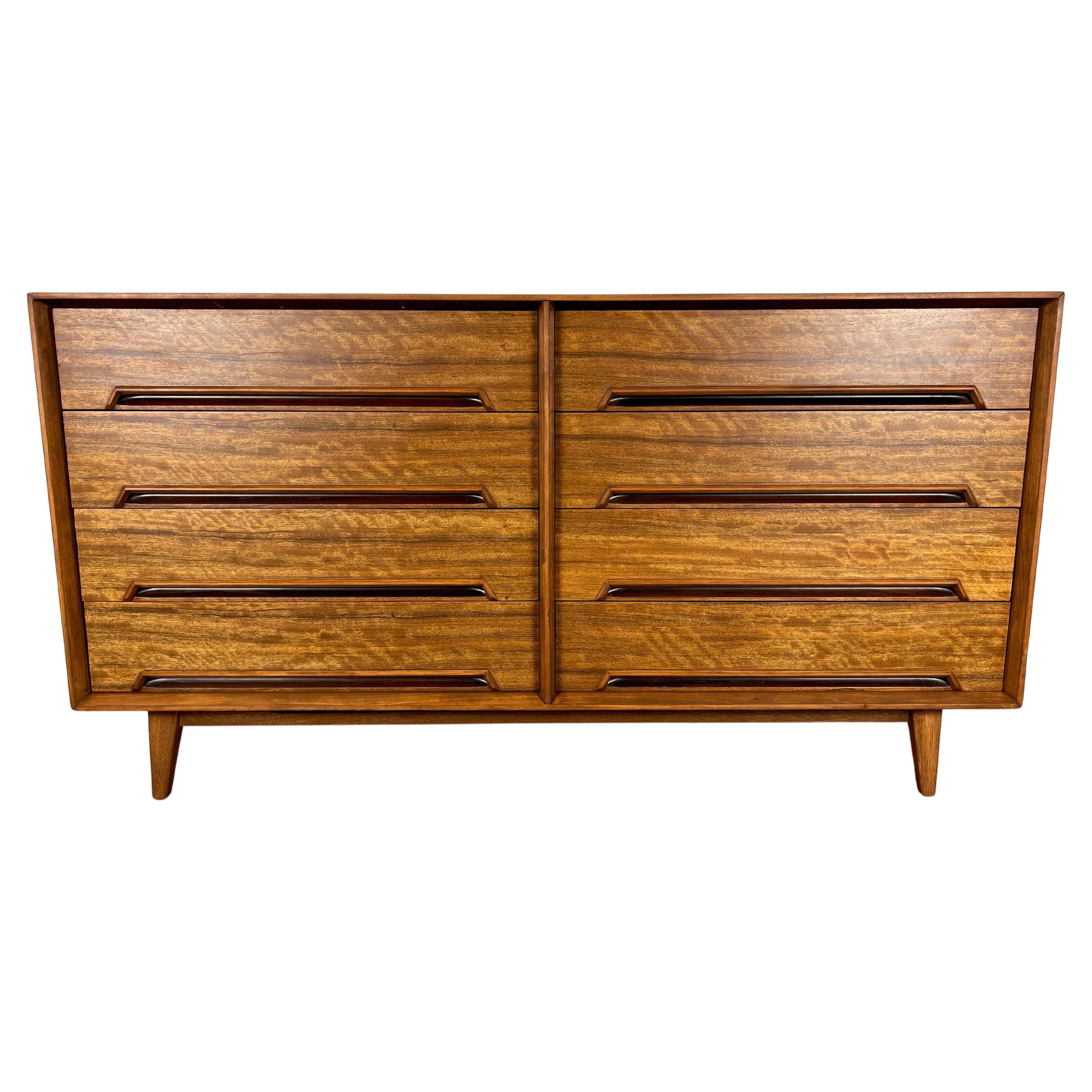Midcentury "Perspective" Dresser by Milo Baughman for Drexel
About the Item
- Creator:Milo Baughman (Designer),Drexel (Manufacturer)
- Dimensions:Height: 32.75 in (83.19 cm)Width: 63 in (160.02 cm)Depth: 19 in (48.26 cm)
- Style:Mid-Century Modern (Of the Period)
- Materials and Techniques:
- Place of Origin:
- Period:
- Date of Manufacture:1950
- Condition:Refinished. Professionally Refinished.
- Seller Location:North Hollywood, CA
- Reference Number:1stDibs: LU1270232698502
Milo Baughman
Milo Baughman was one of the most agile and adept modern American furniture designers of the late 20th century. A prolific lecturer and writer on the benefits of good design — he taught for years at Brigham Young University — Baughman (whose often-scrambled surname is pronounced BAWF-man) focused almost exclusively on residential furnishings, such as chairs, sofas and benches. He had a particular talent for lounge chairs, perhaps the most sociable piece of furniture.
Like his fellow adoptive Californians Charles and Ray Eames, Baughman’s furniture has a relaxed and breezy air. He was famously opposed to ostentatious and idiosyncratic designs that were made to excite attention. While many of his chair designs are enlivened by such effects as tufted upholstery, Baughman tended to let his materials carry the aesthetic weight, most often relying on seating and table frames made of sturdy and sleek flat-bar chromed metal, and chairs, tables and cabinets finished with highly-figured wood veneers.
Like his colleagues Karl Springer and the multifarious Pierre Cardin, Baughman’s designs are emblematic of the 1970s: sleek, sure and scintillating.
As you will see from the furniture presented on 1stDibs, Milo Baughman’s designs for the likes of Drexel Furniture, Glenn of California and — for five decades — Thayer Coggin are ably employed as either the heart of a décor or its focal point.
Drexel
While vintage Drexel Furniture dining tables, dressers and other pieces remain highly desirable for enthusiasts of mid-century modern design, the manufacturer's story actually begins decades before its celebrated postwar-era Declaration line took shape.
In 1903, in the small town of Drexel in the foothills of North Carolina’s Blue Ridge Mountains, six partners came together to found a company that would become one of the country’s leading furniture producers. The first offerings from Drexel Furniture were simple: a bed, washstand and bureau all crafted from native oakwood, sold as a bedroom suite for $14.50.
One of Drexel’s early innovations was to employ staff designers, something the company initiated in the 1930s. This focus on design, which few other furniture companies were committing to at the time, allowed Drexel to respond to a variety of new and traditional tastes. This included making pieces inspired by historic European furniture, like the popular French Provincial–style Touraine bedroom and dining group that borrowed its curves from Louis XV-era furniture. Others replicated the ornate details of 18th-century chinoiserie or the embellishments of Queen Anne furniture. Always ready to adapt to new customer demands, during World War II, Drexel built a sturdy desk designed especially for General Douglas MacArthur.
In the postwar era, Drexel embraced the clean lines of mid-century modernism with the Declaration collection designed by Stewart MacDougall and Kipp Stewart that featured elegant credenzas and more made in walnut, and the Profile and Projection collections designed with sculptural shapes by John Van Koert. In the 1970s, Drexel introduced high-end furniture in a Mediterranean style.
Drexel changed hands and visions throughout the years. It was managed by one of the original partners — Samuel Huffman — until 1935, at which time his son Robert O. Huffman took over as president. It was then that the company began to expand, with several acquisitions of competitors in the 1950s, including Table Rock Furniture, the Heritage Furniture Co. and more.
With the manufacturer’s success — spurred by its embrace of advertising in home and garden magazines — it opened more factories in both North and South Carolina. By 1957, the company that had started with a factory of 50 workers had 2,300 employees and was selling its furniture nationwide.
Drexel underwent a series of name changes in its long history. Its acquisition of Southern Desk Company in 1960 bolstered its production of institutional furniture for dormitories, classrooms, churches and laboratories.
In the following decades, contracts with government agencies, hotels, schools and hospitals brought its high-quality furniture to a global audience. U.S. Plywood-Champion Papers bought Drexel Enterprises in 1968, and it became Drexel Heritage Furnishings.
In 2014, the last Drexel Heritage plant, in Morganton, North Carolina, reportedly closed its doors. The company rebranded as Drexel in 2017.
The vintage Drexel furniture for sale on 1stDibs includes end tables designed by Edward Wormley, walnut side tables designed by Kipp Stewart and lots more.
- ShippingRetrieving quote...Ships From: North Hollywood, CA
- Return PolicyA return for this item may be initiated within 2 days of delivery.
- Glenn of California Walnut and Lacquered Dresser by Milo BaughmanBy Milo Baughman, Glenn of CaliforniaLocated in North Hollywood, CABeautiful vintage two-tone dresser designed by the iconic designer Milo Baughman for Glenn of California in the United States, circa 1950s. This dresser has a minimalist design that ...Category
Vintage 1950s American Mid-Century Modern Dressers
MaterialsStainless Steel
- Vintage Lacquered and Brass DresserLocated in North Hollywood, CAWonderful vintage lacquered and brass dresser designed and manufactured in the United States, circa 1980s. This dresser has an architectural design whe...Category
Vintage 1980s American Mid-Century Modern Dressers
MaterialsBrass
- Danish Modern Teak Highboy by Svend a. Madsen for FalsterBy Falster Møbelfabrik, Svend Åge MadsenLocated in North Hollywood, CAWonderful Danish modern teak highboy designed by Svend Age Madsen for Falster Møbelfabrik in Denmark, circa 1960s. This highboy has a conservative design but stands out thanks to the...Category
Vintage 1960s Danish Mid-Century Modern Commodes and Chests of Drawers
MaterialsTeak
- Vintage Cerused and Brass Chest of Drawers by Paul Frankl for Brown SaltmanBy Paul Frankl, Brown SaltmanLocated in North Hollywood, CAVintage chest of drawers / tall dresser designed by Paul Frankl for Brown Saltman, circa 1950s. This beautiful chest of drawers features four large pull-out dovetailed drawers, all i...Category
Vintage 1950s American Mid-Century Modern Commodes and Chests of Drawers
MaterialsBrass
- Vintage Oak and Brass Chest of Drawers by Paul Frankl for Brown SaltmanBy Paul Frankl, Brown SaltmanLocated in North Hollywood, CAStunning vintage oak and brass chest of drawers / tall dresser designed by Paul Frankl for Brown Saltman, circa 1950s. This beautiful chest of drawer’s features a Minimalist but highly functional design that highlights the elegance of the oak wood used for its construction. The contrast offered between the different shades of oak and mahogany wood makes the dresser's structure stand out even more and captivates the viewer's eye. Features four large pull-out dovetailed drawers, all integrated with original brass X-pulls. Its spacious drawers make it the ideal home addition for storing bedroom essentials...Category
Vintage 1950s American Mid-Century Modern Commodes and Chests of Drawers
MaterialsBrass
- Midcentury Walnut Dresser by Merton L. Gershun for American of MartinsvilleBy American of Martinsville, Merton GershunLocated in North Hollywood, CAFabulous mid century walnut and lacquered dresser designed by Michael L. Gershun for American of Martinsville in the United States, circa 1960s. This credenza has been constructed from the highest quality walnut wood. Features a white lacquered box...Category
Vintage 1960s American Mid-Century Modern Credenzas
MaterialsBrass
- Mid Century Milo Baughman “Perspective” Dresser for DrexelBy Milo Baughman, DrexelLocated in Brooklyn, NYStunning mid century modern “Perspective” walnut dresser designed by Milo Baughman for Drexel furniture. This dresser is equipped with 6 wide and deep drawers that function very smoo...Category
Mid-20th Century American Mid-Century Modern Dressers
MaterialsWalnut
- Milo Baughman Dresser for DrexelBy Milo Baughman, DrexelLocated in Oak Harbor, OHDesigner: Milo Baughman Manufacturer: Drexel Period/Model: Mid-Century Modern Specifications: Wood Condition This Milo Baughman dresser for Drexel is in excellent restor...Category
Vintage 1950s American Mid-Century Modern Dressers
MaterialsWood
- Mahogany Dresser for Drexel PerspectiveBy DrexelLocated in Denton, TXMahogany eight drawer dresser designed by Milo Baughman for Drexel. The legs pictured are vintage but not the original.Category
20th Century Mid-Century Modern Dressers
MaterialsMahogany, Oak
- Matched pair of Milo Baughman Dressers for Drexel USA - 1950sBy Drexel, Milo BaughmanLocated in Berlin, DEMatched pair of Milo Baughman Dressers for Drexel, USA 1950s. Both pieces have the same veneer and are in very good condition. Signed! The measurements given apply to the credenza. H...Category
Vintage 1950s Mid-Century Modern Commodes and Chests of Drawers
MaterialsWood
- Large Casa Del Sol Dresser by John Van Koert for DrexelBy Drexel, John Van KoertLocated in New York, NYStylish 8-drawer dresser Casa Del Sol designed by John Van Koert for Drexel. This dresser features for smaller drawers over four larger drawers creating a...Category
Mid-20th Century American Mid-Century Modern Dressers
MaterialsWood
- Mid-Century Modern Milo Baughman Sideboard / Dresser, Burlwood, ChromeBy Milo BaughmanLocated in Stamford, CTMid-Century Modern Milo Baughman Sideboard / Dresser, Burlwood, Chrome Gorgeous mid-century dresser or sideboard designed and produced in the United States, circa 1980s. This piece is made of burlwood with chrome accents and details. Very decorative square patchwork wood...Category
Late 20th Century American Mid-Century Modern Dressers
MaterialsChrome







